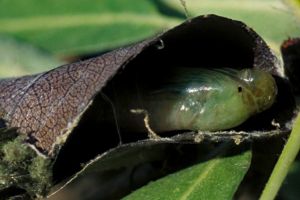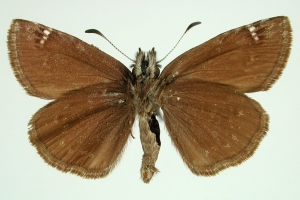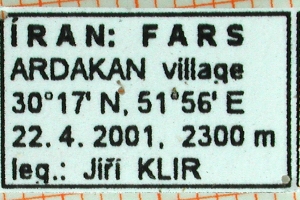

 +17Kontinente:EUAS
+17Kontinente:EUAS1. Lebendfotos
1.1. Falter
1.2. Eiablage
1.3. Ausgewachsene Raupe
1.4. Puppe
1.5. Ei
2. Diagnose
2.1. Männchen
2.2. Weibchen
2.3. Raupe
2.4. Erstbeschreibung
3. Biologie
3.1. Nahrung der Raupe
- [Rosaceae:] Pyrus spinosa [= Pyrus amygdaliformis] (Pfirsichblättrige Birne)
- [Rosaceae:] Prunus cocomilia (Italienische Pflaume)
- [Rosaceae:] Cotoneaster nummularius (Rundblättrige Zwergmispel) [Mt. Hermon]
- [Convolvulaceae:] Convolvulus libanoticus ?? [= Convolvulus libanotica ??] (Libanon-Winde ??)
Die Raupennahrung von E. marloyi war lange völlig unbekannt. Lafranchis (2003) war anscheinend der erste, der etwas dazu schrieb. Lafranchis (2019: 114) fasste zusammen: "This little-known butterfly is the only European Hesperiidae species whose larva feeds on shrubs (Lafranchis, 2003a). The yellow eggs are laid singly mostly on the woody twigs of Pyrus spinosa Forssk., in the mountains also on short Prunus cocomilia Ten. (Rosaceae). Larvae fed on both these plants and accepted Prunus spinosa L. in captivity."
W. Wagner zeigt auf seiner Artseite [Artseite auf pyrgus.de] Eier, Raupen und Puppen und schreibt dazu: "Die Eiablage erfolgt ausschließlich an strauchartig wachsenden Rosaceae. Hierbei werden niedrigwüchsige Pflanzen in xerothermer Lage deutlich bevorzugt. Ich fand Eier und Jungraupen im Askion-Gebirge in Nordgriechenland Ende Mai 2010 ausschließlich an der Birne Pyrus spinosa. Daneben werden offenbar auch Prunus-Arten wie Prunus cocomilia (nach Lafranchis 2003) oder wahrscheinlich auch Prunus spinosa (wird in der Zucht problemlos angenommen) genutzt. Möglicherweise kommen noch weitere Arten hinzu (Crataegus?)." Die Art nutzt damit völlig andere Pflanzen als Erynnis tages.
Benyamini & John (2020: 134) ergänzen für den Mt. Hermon Cotoneaster nummularius.
Doch es gibt ein Kontrastprogramm, dessen Ausgangsbasis mir noch unklar ist. So heißt es bei Tshikolovets (2011: 41): "Hostplant: Convolvulus libanotica". Benyamini & John (2020: 134) akzeptieren das und kommentieren: " [...] Convolvulaceae: Convolvuluus libanotica in Hatay (Atahan et al., 2018: 158)." Dabei übersahen sie, dass Atahan et al. (2018) keine eigene Eiablagebeobachtung und auch keinen Raupenfund in der Süd-Türkei melden konnten, sondern die Angabe ohne Zitat in knappster Form aus der Literatur übernahmen: "Very rare. Flies between 300m and 1450m. Habitat: Arid stony fields. Hostplant: Convolvulus libanotica." Convolvulus libanotica ist Nahrungspflanze von Spialia phlomidis. Sehr wahrscheinlich liegt hier also eine Verwechslung vor.
(Autor: Erwin Rennwald)
4. Weitere Informationen
4.1. Etymologie (Namenserklärung)
„Marloy.“
4.2. Andere Kombinationen
- Thanaos marloyi Boisduval, 1834 [Originalkombination]
4.3. Synonyme
- Erynnis sericea Freyer, [1838]
- Erynnis rustan Kollar, [1849]
4.4. Faunistik
E. marloyi ist in Europa auf dessen Südosten (Bulgarien, Albanien, Mazedonien, Griechenland inkl. Nordägäische Inseln, Türkei) beschränkt.
4.5. Publikationsjahr der Erstbeschreibung
Boisduvals « Icones historique [sic] » sind im Zeitraum von mehreren Jahren in Lieferungen erschienen. So lange uns noch nicht die Arbeit von Cowan (1970) vorliegt, bleiben wir bei dem von der Fauna Europaea angegebenen Jahr 1834.
4.6. Literatur
- Atahan, A., Atahan, G., Gül, M. & M. Atahan (2018): Hatay’ın Kelebekleri Butterflies of Hatay. – 179 S.; Ankara.
- Benyamini, D. & E. John (2020): Butterflies of the Levant and nearby areas. Vol. II: Papilionidae, Pieridae & Hesperiidae. - 208 S.; Eit-Arye (Israel) (4D Microrobotics).
- Erstbeschreibung: Boisduval („1832“): Icones historique des lépidoptères nouveaux ou peu connus. Collection, avec figures colorées, des papillons d'Europe nouvellement découverts; ouvrage formant le complément de tous auteurs iconographes: 1-251, pl. 1-46. Paris (Librairie Encyclopédique de Roret). — Digitalisat der Bibliothèque nationale de France: [241], [pl. 47 mit figs. 6-7].
- Cowan, C. F. (1970): Boisduval's Icones Historiques des Lépidoptères d'Europe "1832" [-1841]. — Journal of the Society for the Bibliography of Natural History 5 (4): 291-302 [Sekundärzitat nach euppublishing.com].
- Kızıldağ, S. (2021): Molecular Evaluations and Genetic Divergence of Erynnis tages and Erynnis marloyi (Lepidoptera, Hesperiidae) Based on mtCOI Gene with Turkey Populations. — Yuzuncu Yil University Journal of Agricultural Science 31 (2): 466-471. [Zum PDF auf researchgate.net]
- Lafranchis, T. (2003): Biologie, écologie et répartition d’Erynnis marloyi (Boisduval, 1834) en Grèce (Lepidoptera: Hesperiidae). — Linneana Belgica, 19: 135–139. [Sekundärzitat]
- Lafranchis (2019) Notes on the biology of some butterflies in Greece (Lepidoptera: Papilionoidea). — Entomologist’s Gazette, 70: 113–134. [PDF auf diatheo.weebly.com]
- Wagner, W. (2006): Die Gattung Pyrgus in Mitteleuropa und ihre Ökologie. — Larvalhabitate, Nährpflanzen und Entwicklungszyklen. (In: Fartmann, T., & Hermann, G. (Hrsg.), Larvalöko logie von Tagfaltern und Widderchen in Mitteleuropa.) — Abhandlungen aus dem Westfälischen Museum für Naturkunde 68 (3/4): 83–122.























































